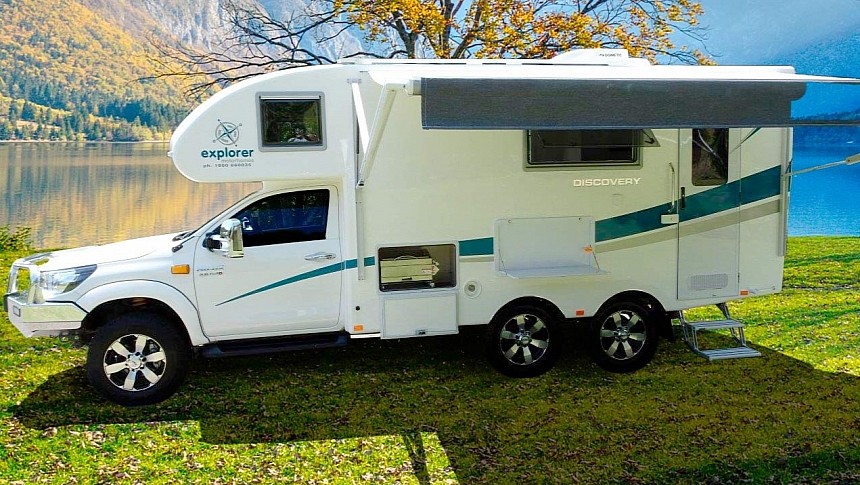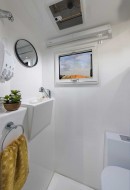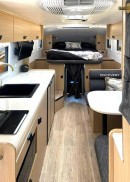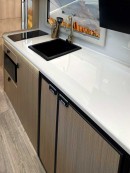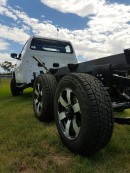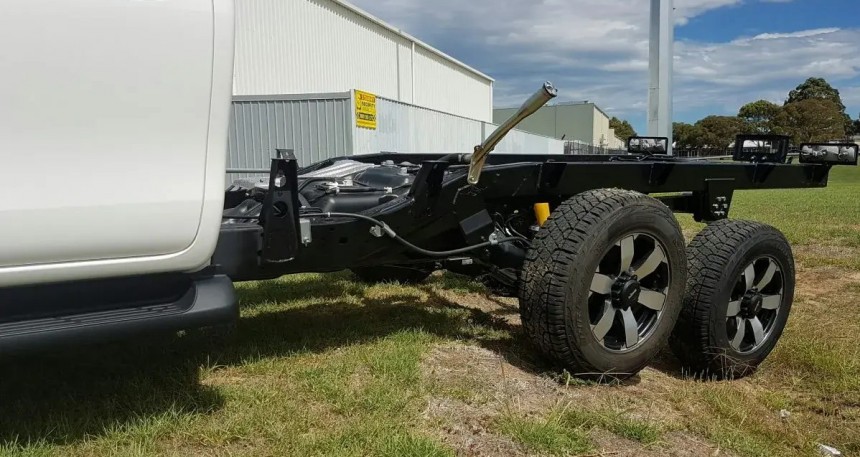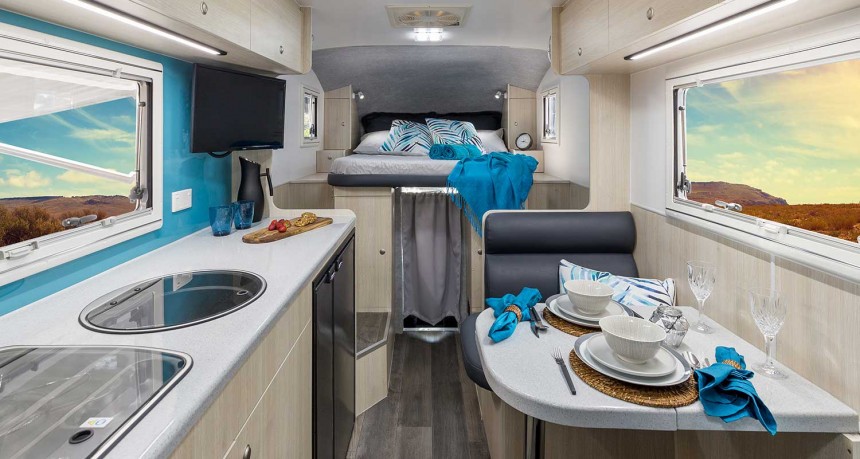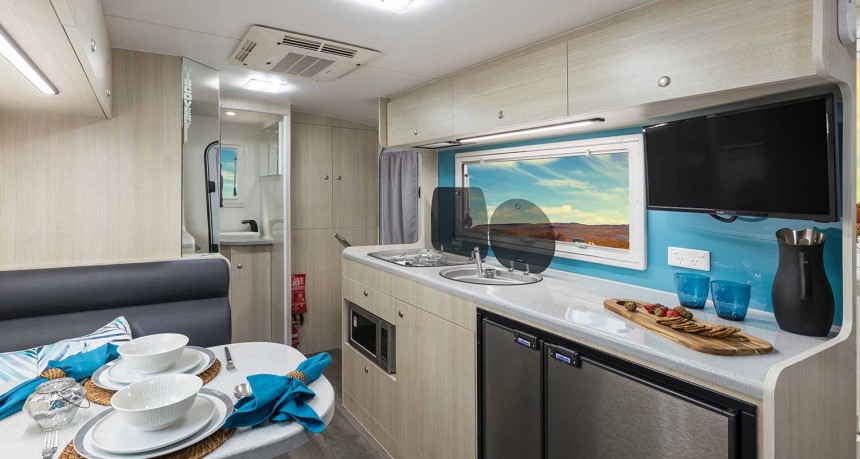By now, most of the world has picked up on the fact that Australia is on a whole different level when it comes to on-road living. It may have a whole lot to do with the fact that the landscape is so dang treacherous. Well, buckle up for his next one and let Explorer Motorhomes show us how off-road and off-grid living is meant to be done.
Ladies and gentlemen, before us lies one of Australia's meanest and most equipped motorhomes that I've run across in quite some time. Be sure to take a moment to fully explore the images in the gallery to see what I mean.
It's called the Discovery, a truck camper built by Explorer Motorhomes, one of Australia's family-owned and operated brands. This is a big deal as it allows them to work outside industry norms, and all this freedom is pumped into the Discovery. Heck, they even offer a 4x4 or 6x6 wheeled variation, the latter of which comes across like the Mars rover of motorhomes.
Now, the Discovery is built to be a long-term on-road living solution, and as such, it's packed full of goodies designed to keep you safe, comfortable, rested, clean, and well-fed; it really can be a "home away from home." Let's see what's in store for a starting price of around $300K Australian ($201K American at current exchange rates), depending on options and the base vehicle chosen. Sure, it's a lot of cash no matter the country you live in, but there's a whole lot of habitat to be had.
For example, I mentioned that this price depends on the base vehicle chosen, and if I've deciphered the brochure properly, four different base vehicles can be chosen. This includes a Toyota Hilux SR, a Ford Ranger XL, a Mazda BT-50, and an Isuzu D-Max.
Once you've picked your vehicle and chassis style, Explorer comes in and drops a one-piece fiberglass shell on top of it all. A one-piece construction is important if you're going to be living out of this habitat for long periods of time and if you're going to expose it to all kinds of elements and natural events. From rain to snow and even dust, one-piece habitats are revered for their ability to repel those particles.
Then there's the foam core insulation Explorer drops in between the exterior and interior panels. According to the manufacturer, it's designed to keep us cool in the summer and warm in the winter, leading me to believe that year-round living is possible, as it should be in a $200K machine.
What I particularly enjoy about the Discovery, or most Australian units, for that matter, is their inclination toward outdoor living. From awnings to storage bays, outdoor shower hookups, and even an outdoor galley block - there's one inside, too - all of this puppy screams outdoor adventure and living.
As for the interior, depending on which of the two available floorplans you choose from, you'll access the living space via lateral entry, either from the rear or front of the shell or directly from the cab, by squeezing through pass-through underneath the forward bedding.
Once inside, be sure to wander through that main corridor that spans the length of either floorplan. From here, Explorer lined the wall of this motorhome with all the goodies you need to live a full on-road life. Yes, even a bathroom with separate features is available. One layout even includes a his and her dresser.
Be sure to take the time to explore all the little goodies that make up the living space. I'm talking about the leatherette upholstery, workspace table, sink and range, and all the sockets and lighting all over the place. I also enjoy the simple but effective use of overhead storage bins.; more than enough for a family of four.
What about off-grid living features and the basics we need to live off the local lands? For this, Explorer drops not one, not two, but three 130 W solar panels into each Discovery, two house batteries, 150 liters (40 gals) of fresh water, and countless other options can be had. My favorite is the snorkel; telling me all I need to know about what Explorer has achieved here today. I think you can see where I'm going with this.
There's just one catch to all of this magic: if you're living outside of Australia, the chances of you getting your hands on this are pretty slim. Not that you don't have the cash to do so - if you're reading this article - you probably do; it's just that campers and motorhomes from the land down under, or rather, any land for that matter, are built and tuned to their local road laws and building regulations.
In short, if you don't live in Australia, the Discovery will only serve as inspiration for your next overlanding project. Just a little something-something to consider if you're looking for a habitat done right.
It's called the Discovery, a truck camper built by Explorer Motorhomes, one of Australia's family-owned and operated brands. This is a big deal as it allows them to work outside industry norms, and all this freedom is pumped into the Discovery. Heck, they even offer a 4x4 or 6x6 wheeled variation, the latter of which comes across like the Mars rover of motorhomes.
Now, the Discovery is built to be a long-term on-road living solution, and as such, it's packed full of goodies designed to keep you safe, comfortable, rested, clean, and well-fed; it really can be a "home away from home." Let's see what's in store for a starting price of around $300K Australian ($201K American at current exchange rates), depending on options and the base vehicle chosen. Sure, it's a lot of cash no matter the country you live in, but there's a whole lot of habitat to be had.
Once you've picked your vehicle and chassis style, Explorer comes in and drops a one-piece fiberglass shell on top of it all. A one-piece construction is important if you're going to be living out of this habitat for long periods of time and if you're going to expose it to all kinds of elements and natural events. From rain to snow and even dust, one-piece habitats are revered for their ability to repel those particles.
Then there's the foam core insulation Explorer drops in between the exterior and interior panels. According to the manufacturer, it's designed to keep us cool in the summer and warm in the winter, leading me to believe that year-round living is possible, as it should be in a $200K machine.
As for the interior, depending on which of the two available floorplans you choose from, you'll access the living space via lateral entry, either from the rear or front of the shell or directly from the cab, by squeezing through pass-through underneath the forward bedding.
Once inside, be sure to wander through that main corridor that spans the length of either floorplan. From here, Explorer lined the wall of this motorhome with all the goodies you need to live a full on-road life. Yes, even a bathroom with separate features is available. One layout even includes a his and her dresser.
What about off-grid living features and the basics we need to live off the local lands? For this, Explorer drops not one, not two, but three 130 W solar panels into each Discovery, two house batteries, 150 liters (40 gals) of fresh water, and countless other options can be had. My favorite is the snorkel; telling me all I need to know about what Explorer has achieved here today. I think you can see where I'm going with this.
There's just one catch to all of this magic: if you're living outside of Australia, the chances of you getting your hands on this are pretty slim. Not that you don't have the cash to do so - if you're reading this article - you probably do; it's just that campers and motorhomes from the land down under, or rather, any land for that matter, are built and tuned to their local road laws and building regulations.
In short, if you don't live in Australia, the Discovery will only serve as inspiration for your next overlanding project. Just a little something-something to consider if you're looking for a habitat done right.
